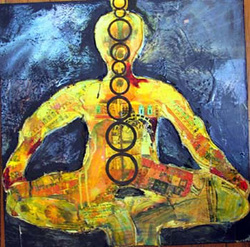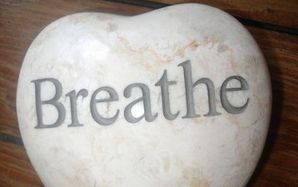
In nadi shodhanam, we breathe through one nostril and then the other, alternating sides in rounds. This breathing technique helps to calm, balance, and regulate both physical and subtle energies. Nadi shodhanam pranayama offers many benefits. It helps to balance and harmonize the body and mind, while deepening inner awareness. While practicing nadi shodhanam pranayama, you are breathing deeply and consciously. This practice is used to balance the 2 sides of the nervous system----the sympathetic that controls “fight or flight” and the parasympathetic that manages “rest and digest”----to regulate stress and relaxation.
Instructions:
Cup your nose with the thumb and the last 2 finders of your right hand. Place your thumb against your right nostril and your last 2 fingers against the left . Press your thumb to close the right nostril while relaxing the fingers to leave the left nostril open. Inhale through the left nostril for a 5-10 count, hold the breath for the same count, and then press your fingers to close the left nostril and exhale on the right side for the same count. Now do the same with the other side by keeping your fingers pressed on the left nostril, while relaxing your thumb to leave the right nostril open. Inhale through the right nostril for 5-10 counts, hold the breath for the same count and then press your thumb to close the right nostril and exhale on the left side for the same count.
Overview:
Inhale left, hold, exhale right, inhale right, hold, exhale left. (One round) Repeat 5-20 rounds.

The 2/1 count meditation is similar to the 10-count meditation, but instead of counting to 10 with each inhale, you will internally say 2 and with each exhale say 1.
This technique is great because it keeps you present without feeling like you are trying to finish something. It is easy to get caught up in the counting and the 2/1 practice allows you to soften a little deeper into the Self, while supporting your mind with “something to do.” Starting with the 2 count on the inhale goes against the natural tendency enough to keep us present without feeling like there is an endpoint to accomplish. Try to sustain this practice for 5-20 minutes daily.
For classes and programs with Mayuri, please visit www.prasanthsitudio.com.
This is a time of year that many of us take the time to reflect on the past year and envision the year ahead. This can be a powerful practice which can set the stage for transformation and awakening. However, be leery of the negative dialogue that can beat you up reminding you of all the things that you should have already done or the inner critic that tears you apart. What is done is done. There is no other option for what was. All we can do is reinvent this moment, and each moment after that. One moment at a time. One breath at a time.
In yoga, we practice with the body we have right now and make space to grow and develop into the being that we deeply desire. So allow your 2013 to begin with courage and connection, rather then getting frustrated with yourself and your lack of progress or discipline doing what you "should" be doing. Make a conscious commitment to deeply love and care for yourself.
Plunge into 2013 with love, courage and confidence.




 RSS Feed
RSS Feed